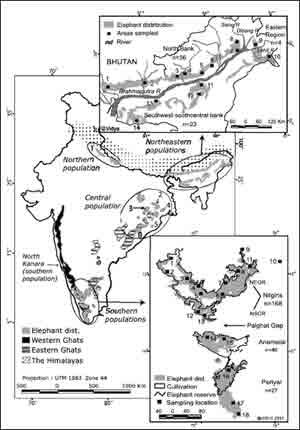Genetic Analysis of Asian Elephants in India Reveals Some Surprises

After analyzing DNA in elephant dung, the authors of a new study in Animal Conservation found that the country’s northeast elephant population is actually made up of two genetically distinct groups separated by the Brahmaputra River. An earlier study by the same authors showed that the southern populations are also genetically distinct, separated by the Palghat Gap.
Researchers find one population actually two; suggest strategies for future elephant conservation
Researchers in India and from The Earth Institute at Columbia University have discovered that one of the few remaining populations of Asian elephants in India is actually two genetically distinct groups. The results of the study, which appear in the current issue of the journal Animal Conservation, could have far-reaching implications in conservation plans for the endangered elephants as well as other species on the Subcontinent.
Prithiviraj Fernando, a post-doctoral researcher at the Center for Environmental Research and Conservation (CERC), and Don Melnick, executive director of CERC, together with colleagues from the Centre for Ecological Science at the Indian Institute of Science collected dung samples from nearly 300 wild Asian elephants and 30 captive elephants for which reliable capture information existed. They then examined DNA from the samples and found that, of the distinct populations found in India, the groups that inhabit the forests in the northeast of the country is actually composed of two genetically distinct populations separated by the Brahmaputra River.
Despite the low and declining numbers of Asian elephants, relatively little is known about their genetic diversity—information that is crucial to plans for preserving the species. An earlier study of elephants in southern India by the same group identified two distinct populations where there was previously thought to be only one. A region known as the Palghat Gap, a wide pass through the Western Ghat mountain range, was found to act a biogeographical barrier between the two in that case.
“It is interesting that the Brahmaputra seems to have been a biogeographical barrier for several species,” the authors write in their most recent study. “Population genetic studies of other species would be helpful in corroborating whether the Palghat Gap and the Brahmaputra River have served as important biogeographical barriers to a broad range of taxa and thus should be considered in future conservation planning.”
The Asian elephant (Elephas maximus) is recognized by the World Conservation Union (IUCN) as an endangered species, with an estimated 22,700 to 32,400 individuals remaining, more than half of which are in India. Elephant numbers throughout Asia have declined drastically over the last several hundred years, mainly due to habitat loss and fragmentation, capture and domestication, and, more recently, poaching of males for ivory.
To combat these declines, India established 11 so-called “elephant ranges” that incorporate more than half of the known elephant habitat. Fewer than half of these ranges, however, offer the much stricter protections provided by wildlife sanctuaries or national parks. Moreover, India is projected to overtake China as the world’s most populous country by 2030, a fact that almost certain to bring about increased competition for space between humans and elephants.
Still, Melnick and his colleagues are confident that their work represents a crucial step in efforts to protect an animal that is deeply rooted in Indian culture. “If we are going to find a way to protect elephants for future generations, we need to preserve the greatest genetic diversity possible.” says Melnick. “We’re just acting blind if we don’t know where that diversity is. This study shows us where we need to focus our efforts.”
The Earth Institute at Columbia University is the world’s leading academic center for the integrated study of Earth, its environment and society. The Earth Institute builds upon excellence in the core disciplines — earth sciences, biological sciences, engineering sciences, social sciences and health sciences — and stresses cross-disciplinary approaches to complex problems. Through research, training and global partnerships, it mobilizes science and technology to advance sustainable development, while placing special emphasis on the needs of the world’s poor. For more information, visit www.earth.columbia.edu.
The Center for Environmental Research and Conservation (CERC), the principal ecology and biodiversity unit of The Earth Institute at Columbia University, is an unrivaled consortium of five world-class scientific institutions – Columbia University, the American Museum of Natural History, The New York Botanical Garden, Wildlife Conservation Society and Wildlife Trust. The Center seeks to build environmental leadership and find long-term solutions to combat biological diversity loss and natural resource depletion, while meeting the needs of a growing human population.
Media Contact
More Information:
http://www.columbia.eduAll latest news from the category: Ecology, The Environment and Conservation
This complex theme deals primarily with interactions between organisms and the environmental factors that impact them, but to a greater extent between individual inanimate environmental factors.
innovations-report offers informative reports and articles on topics such as climate protection, landscape conservation, ecological systems, wildlife and nature parks and ecosystem efficiency and balance.
Newest articles

Silicon Carbide Innovation Alliance to drive industrial-scale semiconductor work
Known for its ability to withstand extreme environments and high voltages, silicon carbide (SiC) is a semiconducting material made up of silicon and carbon atoms arranged into crystals that is…

New SPECT/CT technique shows impressive biomarker identification
…offers increased access for prostate cancer patients. A novel SPECT/CT acquisition method can accurately detect radiopharmaceutical biodistribution in a convenient manner for prostate cancer patients, opening the door for more…

How 3D printers can give robots a soft touch
Soft skin coverings and touch sensors have emerged as a promising feature for robots that are both safer and more intuitive for human interaction, but they are expensive and difficult…





















